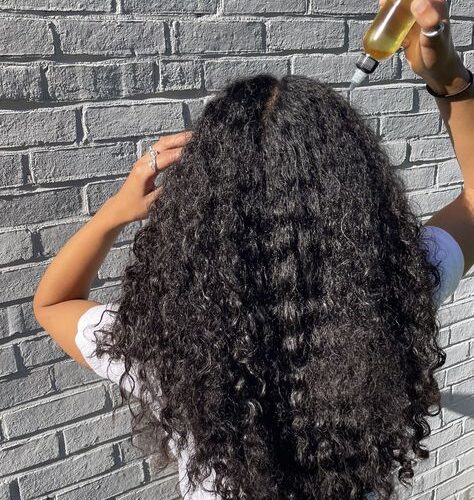The Ultimate Guide To Hair Porosity: Understanding And Caring For Your Hair Type

Hey gorgeous, ever feel like you’re giving your hair everything it needs – luxurious products, fancy treatments, the whole shebang – but it just doesn’t cooperate? Girl, you’re not alone! The truth is, there’s a whole secret language your hair is speaking, and if you don’t understand it, all those products might be working against you.
That’s where hair porosity comes in. It’s the key to unlocking the mysteries of your mane and finally achieving those healthy, bouncy locks you’ve been dreaming of. So, grab a glass of bubbly (because what’s better than gossip and hair care?), and let’s dive into the fascinating world of hair porosity!
Hair Porosity 101: Decoding Your Hair’s Structure
Think of your hair strand like a little house. The outer layer, called the cuticle, is like the roof – it protects the inner core (the cortex) from damage and helps regulate moisture levels. Hair porosity is all about how tightly those roof shingles (cuticles) are packed together.
There are three main hair porosity types:
- Low porosity: Imagine a tightly sealed house. Low-porosity hair has cuticles that lie flat and compact, making it difficult for moisture and products to penetrate. This hair type tends to be resistant to styling and can suffer from dryness and buildup.
- High porosity: Picture a house with gaping holes in the roof. High porosity hair has cuticles that are raised and open, allowing moisture and products to enter and exit easily. This hair type can be prone to frizz and breakage if not properly cared for.
- Medium porosity: Ah, the Goldilocks zone! Medium porosity hair has cuticles that are neither too tight nor too loose, allowing for a good balance of moisture absorption and retention. This hair type is generally the easiest to manage and style.
The Importance Of Knowing Your Hair Porosity
So, why is understanding your hair porosity such a big deal? Because, darling, it’s the key to choosing the right products and styling techniques for your unique hair type! Using the wrong products on high porosity hair can lead to protein overload and breakage, while low porosity hair might struggle to absorb heavy creams and conditioners.
The Ultimate Hair Porosity Quiz: Find Your Hair Type
Ready to unlock the secrets of your mane? Take this quick quiz to determine your hair porosity:
- The Strand Test: Take a clean, dry strand of hair and place it in a glass of water. High porosity hair will sink quickly, medium porosity hair will take a while to sink, and low porosity hair may float for several minutes or even stay afloat altogether.
- The Moisture Absorption Test: Apply a small amount of leave-in conditioner to a clean, dry strand of hair. High porosity hair will absorb the product quickly, medium porosity hair will take some time, and low porosity hair might show little to no absorption.
- The Bleaching Test (Optional): If you’ve ever dyed your hair blonde, this one might be a giveaway. High porosity hair tends to take bleach more readily and can become quite damaged, while low porosity hair might resist lightening altogether.
Remember: These are just general guidelines. Hair can be a beautiful mix of different textures and porosities, so your results might not be perfectly clear-cut. Trust your instincts and what your hair is telling you!
Hair Porosity Powerhouse Products: Pampering Your Locks The Right Way
Now that you know your hair porosity type, it’s time to revamp your hair care routine! Here are some product recommendations to keep your mane happy and healthy:
Low Porosity Haircare Heroes:
- Clarifying Shampoos (Once A Month): Help remove buildup that can prevent moisture penetration. Look for ones with gentle kaolin clay or apple cider vinegar on Amazon like the Briogeo Scalp Revival Stimulating Scalp Scrub with Charcoal & Coconut Oil.
- Lightweight Conditioners & Hair Masks: Opt for products with humectants like glycerin or aloe vera to draw moisture into the hair shaft. Try the luxurious La Mer The Renewal Oil Absorbing Treatment or the Oribe Gold Lust Transformative Masque from Amazon.
- Heat Protectant Sprays: Essential for all hair types, but especially low porosity hair which can be prone to heat damage. Invest in a high-quality spray like the Shu Uemura Essence Absolue Nourishing Protective Oil.
Pro Tip: For low porosity hair, applying heat after a deep conditioning treatment can help open the cuticles and allow for better product absorption. Just use low heat and a diffuser attachment to avoid damage.
High Porosity Haircare Helpers:
- Moisturizing Shampoos & Conditioners: Look for products with emollients like shea butter or coconut oil to lock in moisture and prevent frizz. The Olaplex No. 4 Bond Maintaining Shampoo & Conditioner from Amazon is a celebrity favorite, or try the MoroccanOil Intense Hydrating Mask.
- Protein Treatments (once a week): Protein helps strengthen the hair shaft and prevent breakage. Look for masks or leave-in conditioners with hydrolyzed keratin or rice protein. The Kerastase Resistance Extentioniste Bain Hydra-Fortifiant Shampoo and conditioner from Amazon are a powerful duo.
- Leave-in Conditioners & Hair Oils: These products create a protective barrier on the hair shaft, preventing moisture loss and frizz. A cult favorite is the Amika Nourishing Coconut Milk Leave-In Conditioner, or try the luxurious Oribe Signature Conditioner from Amazon for a splurge.
Pro Tip: High porosity hair can benefit from frequent trims to remove split ends and prevent breakage from traveling up the hair shaft.
Medium Porosity Haircare Must-Haves:
- Balanced Shampoos & Conditioners: You lucky ducks can use a wider variety of products! Look for shampoos and conditioners that cleanse without stripping and provide adequate moisture. The Virtue Restorative Shampoo & Conditioner from Amazon is a great option, or try the Redken All Soft Shampoo & Conditioner for a drugstore find.
- Weekly Deep Conditioning Treatments: Maintain the healthy balance of your hair with a regular deep conditioning routine. The Olaplex No. 3 Hair Perfector from Amazon is a popular choice, or try the Briogeo Don’t Despair, Repair! Deep Conditioning Mask.
- Heat Styling Tools With Temperature Control: Medium porosity hair can handle some heat styling, but it’s important to use tools with adjustable temperature settings and always use a heat protectant spray. The Dyson Supersonic Hair Dryer is a splurge-worthy option, or try the T3 Cura Luxe from Amazon for a more budget-friendly pick.

Hair Porosity: Beyond The Basics
Now that you’ve got the hang of the basics, let’s delve a little deeper into the fascinating world of hair porosity:
Little Known Facts About Hair Porosity:
- Hair Porosity Can Change! Chemical treatments like coloring or relaxing can alter the structure of your hair and affect its porosity. Pregnancy and hormonal changes can also play a role.
- Your Hair Can Have Different Porosity Levels! For example, the roots might be low porosity while the ends are high porosity. This is why it’s important to target your hair care routine to your specific needs.
- Porosity Isn’t The Only Factor! Hair texture, density, and curl pattern also play a role in hair health. Understanding your hair porosity is a valuable piece of the puzzle, but it’s not the whole picture.
Hair Porosity FAQs: Answered!
- Can I improve my hair porosity? Unfortunately, you can’t permanently change your hair porosity. However, you can use targeted hair care routines to manage your specific hair type and achieve healthier, happier locks.
- What should I avoid if I have low porosity hair? Heavy oils, protein overload, and excessive heat styling can all weigh down low porosity hair. Opt for lightweight products and gentle heat styling techniques.
- What should I avoid if I have high porosity hair? Harsh shampoos with sulfates, alcohol-based products, and excessive heat styling can all damage high porosity hair. Focus on gentle cleansing, deep conditioning, and heat protectants.
Remember how we talked about porosity being a journey, not a destination? Well, buckle up, because I’ve got some bonus tips and tricks to keep your hair porosity knowledge on point!
Quick Tips For Busy Bees:
- The Apple Cider Vinegar Rinse: For low porosity hair, a diluted apple cider vinegar rinse (1 tablespoon ACV to 1 cup water) after shampooing can help remove buildup and improve product absorption. Just be sure to follow with a conditioner to avoid dryness.
- The Overnight Deep Condition: High porosity hair thrives on moisture. Apply a generous amount of your favorite deep conditioner to damp hair before bed, wrap your head in a satin or silk scarf, and wash it out in the morning.
- The Pre-poo Treatment: For all hair porosities, a pre-poo treatment with oil (coconut, olive, etc.) can help protect your hair from the drying effects of shampoo. Massage the oil into your scalp and hair before shampooing, focusing on the ends.
DIY Magic For The Adventurous:
- The DIY Hair Mask For Low Porosity: Mix 1 ripe avocado with 1 tablespoon of honey and 1 teaspoon of olive oil. Apply to damp hair for 20 minutes, then wash out with a clarifying shampoo. The avocado and honey provide moisture, while the olive oil helps with penetration.
- The DIY Hair Mask For High Porosity: Combine 1/2 cup of plain yogurt with 1 tablespoon of honey and 1 tablespoon of oat flour. Apply to damp hair for 30 minutes, then wash out with a gentle shampoo. The yogurt and honey provide protein and moisture, while the oat flour helps combat frizz.
- The DIY Hair Rinse for All Porosities: Brew a pot of green tea and let it cool. After shampooing and conditioning, use the green tea as a final rinse to add shine and promote scalp health.
Remember: Always do a patch test before applying any new product or DIY mask to your hair.
Even with all this newfound hair porosity knowledge, there might be times when your mane throws you a curveball. Fear not! We’ve all been there. Here’s a quick guide to troubleshooting some common hair concerns based on hair porosity:
Low Porosity Problems:
- Dryness and Lackluster Hair: This can be caused by product buildup. Use a clarifying shampoo once a month and focus on lightweight, water-based products.
- Difficulty Styling: Low porosity hair can resist styling products. Try applying products to damp hair and using heat after a deep conditioning treatment to improve product absorption.
High Porosity Problems:
- Frizz and Flyaways: This is a common issue with high porosity hair. Use leave-in conditioners and hair oils to create a protective barrier and lock in moisture.
- Breakage: High porosity hair can be prone to breakage. Focus on protein treatments and gentle handling to keep your hair strong and healthy.
General Hair Concerns:
- Hair Loss: Hair loss can be caused by a variety of factors, not just porosity. If you’re experiencing significant hair loss, consult a dermatologist to rule out any underlying medical conditions.
- Dandruff: Dandruff can affect all hair porosities. Use a dandruff shampoo that addresses your specific scalp concerns.
Remember: Consistency is key! Sticking to a regular hair care routine that addresses your hair porosity will give you the best results.
Bonus Tip: Hair porosity can change over time due to various factors like heat styling, coloring, and hormonal changes.Pay attention to your hair’s needs and adjust your routine accordingly.
Understanding your hair porosity is a huge step towards achieving personalized hair care. By tailoring your routine to your hair’s specific needs, you can unlock its full potential and achieve the healthy, beautiful locks you’ve always dreamed of.
From One It Girl To Another, We Should Keep In Touch. Sign Up For Our Emails!
We Have So Much To Update You On. Sign Up For Exclusives, Deals And More.





